Top Performance Winner: BOXX APEXX S3
The latest workstation from BOXX beats the performance of its predecessor.
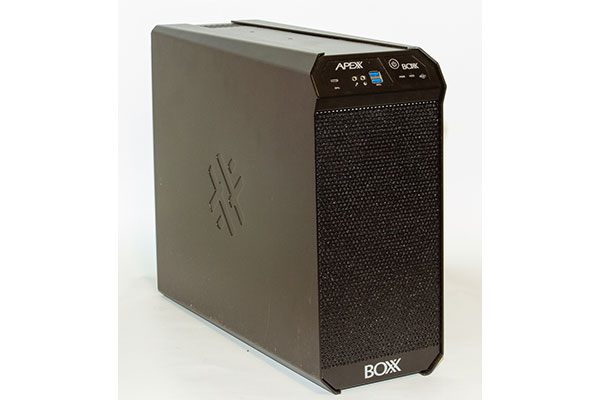
Fig. 1: The new BOXX APEXX S3 workstation from BOXX Technologies features an aluminum chassis with no front-panel drive bays. Images courtesy of David Cohn.
Latest News
August 31, 2023
BOXX has always impressed us with its ability to build top-of-the-line workstations that deliver maximum power without breaking the bank. But it has been several years since we last looked at one of the Austin, TX-based company’s workstations (see “Overclocked and Under Budget”). Happily, when a new edition of the BOXX APEXX S3 workstation recently arrived at our offices, we were more than ready to put it through its paces.
Based on the latest 13th-generation Intel Core processors, the newest iteration of the S3 comes housed in an aluminum chassis quite similar in appearance to the system we reviewed in 2019. Measuring 6.81x17.75x15.0-in. (WxDxH) and weighing just under 26 lbs., the case is all black except for a small, brushed aluminum BOXX logo at the bottom of the removable front panel. As in previous BOXX workstations, that front grille conceals an air filter that is easily removable for cleaning. Behind it are a pair of 4-in. diameter cooling fans and a large radiator, part of the liquid CPU cooling system.
A sloping panel along the top front of the case contains two USB3.2 Type-A ports, a USB3.2 Type-C port, a pair of audio jacks, a round power button with a bright-white LED power indicator, hard drive activity light and a small reset button. A third cooling fan is concealed behind the front panel and blows air through the interior of the case. As was true for the previous version, there are no front-panel drive bays.
The rear panel provides eight more USB3.2 Type-A ports, two USB2.0 Type-A ports, two USB4 Type-C Thunderbolt ports, two RJ45 network jacks, an HDMI port for the CPU’s integrated graphics, two audio connectors (microphone and line-out) and an optical S/PDIF connector. There are also a pair of antenna connectors for built-in Wi-Fi.
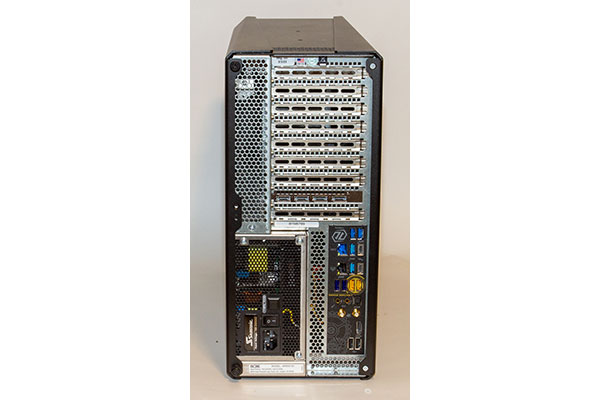
Fig. 2: The rear panel of the BOXX APEXX S3 provides a wealth of connections.
Updated Motherboard and CPU
Though the exterior looks similar to the previous S3, the components we found inside were all new. Loosening a pair of captive screws and removing the rightside panel reveals a spacious interior organized similar to the prior generation. A pair of 3.5-in. drive bays with quick drive mounts hang from the top of the case. Each of these can be split to accommodate a pair of 2.5-in. drives, for a total of up to 32TB of SATA-based storage. But since the new APEXX S3 accommodates up to three M.2-based solid-state drives (SSD), both of these bays were empty in our evaluation unit.
The new BOXX APEXX S3 is built around an ASRock Z790 Tachi EATX form factor motherboard based on the Intel Z790 chipset, with the CPU hidden beneath the liquid cooler. This is then tucked below the 750-watt Seasonic Focus GX-750 80 Plus Gold-rated power supply, which occupies the bottom-rear corner of the case.
Unlike the previous APEXX S3, this time around, BOXX offers a choice of CPUs: an Intel Core i7-13700K 16-core processor included in the base configuration or the Intel Core i9-13900K 24-core processor in the system we received (which added $320). This Raptor Lake CPU includes eight performance cores with a base frequency of 3.0GHz and 16 efficient-cores with a 2.2GHz base frequency, for a total of 32 threads. The P-cores have a maximum turbo boost of 5.4GHz, while the E-cores have a maximum turbo speed of 4.3GHz. Total single-core maximum CPU speed is 5.8GHz, using Intel Turbo Boost Max Technology 3.0 and Intel Thermal Velocity Boost.
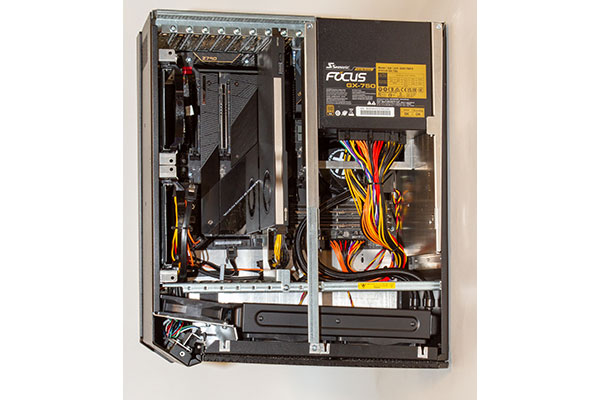
Based on the latest Intel 7 lithography, the CPU has a 38MB Smart Cache, a processor base power of 125 watts and a maximum turbo power of 253 watts. This CPU also includes Intel UHD Graphics 770 and supports error-correcting code memory.
The motherboard provides two PCIe 5.0 x16 slots and one PCIe 4.0 x16 slot and supports AMD Crossfire. The ASRock motherboard also includes an integrated Realtek ALC4082 audio codec for 5.1 HD audio, an integrated Killer LAN that provides up to 2.5 gigabit speeds on one of the rear panel RJ45 ports and up to 1 gigabit on the other, an 802.11ax Wi-Fi 6E module that supports dual-band 2x2 160MHz speeds with extended 6GHz band support, and Bluetooth.
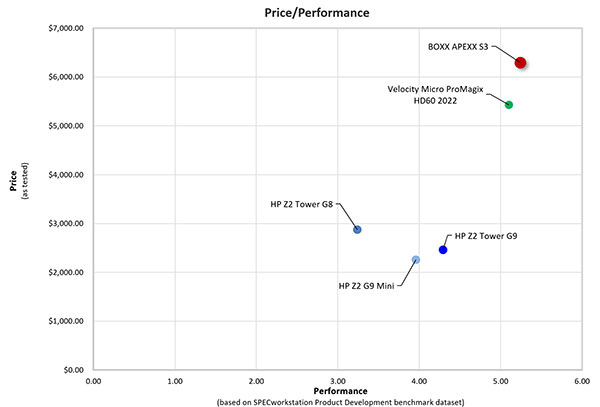
Plenty of Memory, GPU and Drive Choices
At $4,837, the base configuration comes with 32GB of RAM, an NVIDIA RTX A2000 graphics processing unit (GPU) and a 500GB M.2 PCIe drive, making even that entry point a well-equipped workhorse. But for our review, BOXX ramped things up.
The system we received came with 64GB of DDR5-4800MHz memory installed as a pair of 32GB dual in-line memory modules (DIMMS). The additional memory added $206. Since the motherboard provides four memory sockets, this left two more available for future expansion. But the new S3 can accommodate up to 192GB ($1,251) using 48GB DIMMS.
BOXX also offers a wide range of discrete GPU choices. Our evaluation unit included an NVIDIA RTX A4000 graphics card, with 16GB of GDDR6 memory, 6144 Ampere CUDA cores, 192 Tensor cores and 48 RT cores. That board, which increased the system price by $660, provides a 256-bit interface and bandwidth of 448 GB/second, while its 140-watt power consumption requires a six-pin auxiliary power connection.
Other options include NVIDIA GPUs ranging from the T400 to the RTX A6000, including options with NVLINK, as well as the AMD Radeon Pro W6800.
Our evaluation unit also included a 1TB M.2 PCIe drive, a $188 upcharge from the 500GB drive included in the base configuration. BOXX offers other M.2 drives with up to 4GB capacities, so you could have as much as 12GB of solid-state storage. And that’s before you even start adding drives in the two 3.5-in. bays at the top of the case.
Here, BOXX offers SATA drives, with SSD capacities ranging from 240GB to 8TB. By splitting these bays into two 2.5-in. bays, you could add another 32GB of onboard storage (for a whopping $7,740) or use up to two 3.5-in. 7200rpm SATA drives ranging from 2TB to 10TB.
Since our system included a high-core-count CPU, BOXX also preloaded Windows 10 Pro for 6+ cores, which added an additional $84.
Record-Breaking Performance
With its high-end GPU and 24-core CPU, we expected the new BOXX APEXX S3 to perform well. Yet once again, this BOXX workstation still managed to exceed our expectations. On the SPECviewperf tests of graphics performance, the BOXX APEXX S3 achieved some of the highest scores we’ve ever recorded on three of the eight datasets.
Its results on the SPECworkstation 3.1 benchmark were even more impressive, with the BOXX APEXX S3 garnering the top scores on almost every aspect of this incredibly demanding set of tests, including top results on five of the six vertical market test suites. It now ranks at the top in terms of CPU, storage and graphics subsystem performance.
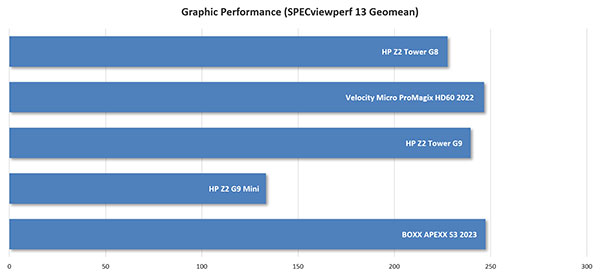
On our AutoCAD rendering test, which clearly shows advantages of fast CPUs with multiple cores, the BOXX APEXX S3 surpassed every other system we’ve ever tested, averaging just 14.2 seconds to complete our test rendering (more than a second faster than the previous record holder).
BOXX rounded out our APEXX S3 with a Logitech K120 104-key USB keyboard and a Logitech M500s laser corded mouse, a $29 upgrade over the standard Logitech M100 mouse. BOXX also offers other input options, including various 3Dconnexion devices.
You have your choice of Windows 10 or Windows 11, and BOXX backs the APEXX S3 with a three-year warranty that covers next business day on-site service with 24/7 phone support during the first year and depot repair service and weekday daytime phone support during the second and third years. Premium support during the second and third years is available in the U.S. and Canada for an additional charge.
As equipped, the new BOXX APEXX S3 we reviewed priced out at $6,295, considerably more than its predecessor. But it delivers performance that beats out competitors costing much more. Even the $4,837 base configuration would likely stack up well against many other systems.
Once again, the new BOXX APEXX S3 represents the best price/performance of any system we have ever tested at DE, making it a perfect choice for anyone doing high-end CAD or 3D modeling.
More BOXX Technologies Coverage
More Intel Coverage
More NVIDIA Coverage
Subscribe to our FREE magazine, FREE email newsletters or both!
Latest News
About the Author
David Cohn is a consultant and technical writer based in Bellingham, WA, and has been benchmarking PCs since 1984. He is a Contributing Editor to Digital Engineering, the former senior content manager at 4D Technologies, and the author of more than a dozen books. Email at david@dscohn.com or visit his website at www.dscohn.com.
Follow DE





